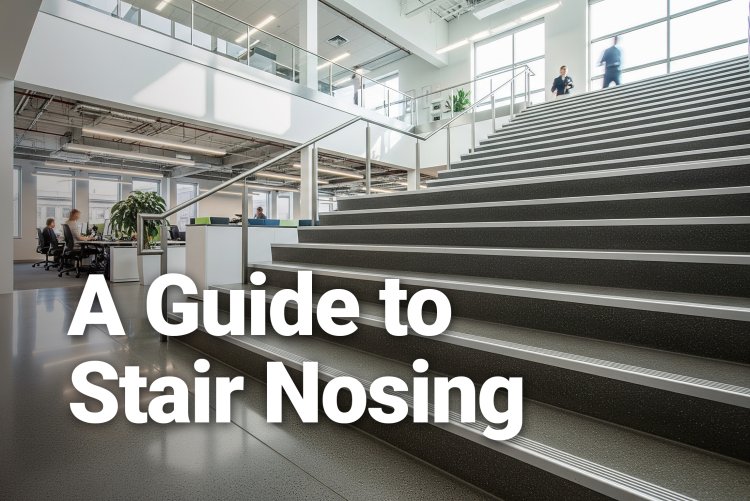
At first glance, stair nosing might seem like a purely aesthetic feature, however, it plays a much more important role than many people realise. Ideal in a public building, school, university, or a commercial setting, stair nosing is a vital safety and durability feature that not only protects the edge of each step but also reduces the risk of trips and falls.
In this article, we’ll take a closer look at what stair nosing actually is, why it matters, whether or not you need it, and what the rules and regulations are for stair nosing in the UK. Whether you're refurbishing a staircase or specifying finishes for a new project, understanding stair nosing is important for safety, compliance, and longevity.
What is the purpose of stair nosing?
The primary purpose of stair nosing is to enhance safety. By creating a clearly defined edge on each step, stair nosing helps to reduce the risk of slips and trips, especially in environments with high foot traffic or varying lighting conditions.
It gives each tread greater visibility and can often incorporate anti-slip features such as ridged surfaces or abrasive inserts to improve grip underfoot. In both commercial and residential environments, this added layer of safety can be critical in preventing accidents, particularly for older individuals or those with impaired vision.
Beyond safety, stair nosing also contributes to the durability of the staircase. Stair treads are subjected to frequent wear, particularly at the front edge, and without protection, this wear can lead to damage over time. A well-designed nosing provides reinforcement to this vulnerable area, helping to maintain the integrity of the step and prolong the life of the flooring material.
From a design perspective, stair nosing can also offer a clean and polished texture to a staircase, with a range of materials and finishes, depending on the surrounding décor and level of usage.
Do I need nosing on stairs?
Whether or not stair nosing is required depends on the setting and usage of the stairs. In domestic environments, nosing isn’t legally required, but it is sometimes recommended. In households with young children, elderly residents or individuals with limited mobility for example, stair nosing can make a notable difference to everyday safety and comfort.
In contrast, for commercial or public buildings, stair nosing is not only advisable, but often essential. Under the Equality Act 2010, building owners and managers must make reasonable adjustments to ensure spaces are accessible to all users, including those with visual impairments.
This is where stair nosing becomes especially important. The Health and Safety Executive (HSE) also provides guidance stating that stairways should be designed to reduce the risk of falls and should include slip-resistant surfaces and clearly marked edges. Therefore, installing appropriate stair nosing becomes part of meeting these legal duties and ensuring that any staircase in a public or commercial setting is fit for purpose.
What are the rules in the UK for stair nosing?
The UK has clear regulations and guidelines regarding stair nosing, particularly in non-domestic buildings. Approved Document K of the Building Regulations outlines the requirements for preventing falls on stairs, ladders and ramps.
One of its stipulations is that steps in a public access stairway should have a contrasting colour on the nosing to make the edge of each tread clearly visible. This colour contrast should be 30 Light Reflectance Value (LRV) points or more to be considered compliant, as defined by the British Standards (BS 8300-2:2018), which offers best practice guidance for designing inclusive and accessible environments.
In addition, nosing should not project more than 25mm beyond the face of the riser below to prevent tripping hazards, and the shape should be consistent throughout the flight. The National Institute for Health and Care Excellence (NICE) has also supported interventions like slip-resistant stair nosings in its guidance for preventing falls in older people, reinforcing the importance of stair nosing in both health and building policy contexts.
Staircases in workplaces are also governed by the Workplace (Health, Safety and Welfare) Regulations 1992, which state that every stair must be suitable for its users, which can include adding appropriate nosing to reduce risk. With safety and compliance increasingly in focus across construction and property management sectors, using high-quality, professionally installed stair nosing is not just a practical step, it’s often a regulatory necessity.
In Summary
Stair nosing may be a small detail in the overall design of a building, but it plays a disproportionately important role in ensuring safety, durability and accessibility. Whether you're working on a residential staircase or specifying finishes for a commercial environment, choosing the right nosing and understanding the relevant regulations can make all the difference.
At Nosings of London, we specialise in bespoke, high-quality stair nosing solutions that combine durability, design excellence and full regulatory compliance, helping your staircases look better, perform better and last longer.
If you're looking for expertly crafted stair nosings that meet UK standards and can be delivered anywhere in the world, we’re here to help. Get in touch with the team at Nosings of London today to discuss your requirements, request a quote or explore our full range of products, we’ll ensure your staircase is safe, stylish and built to last, wherever you are.

